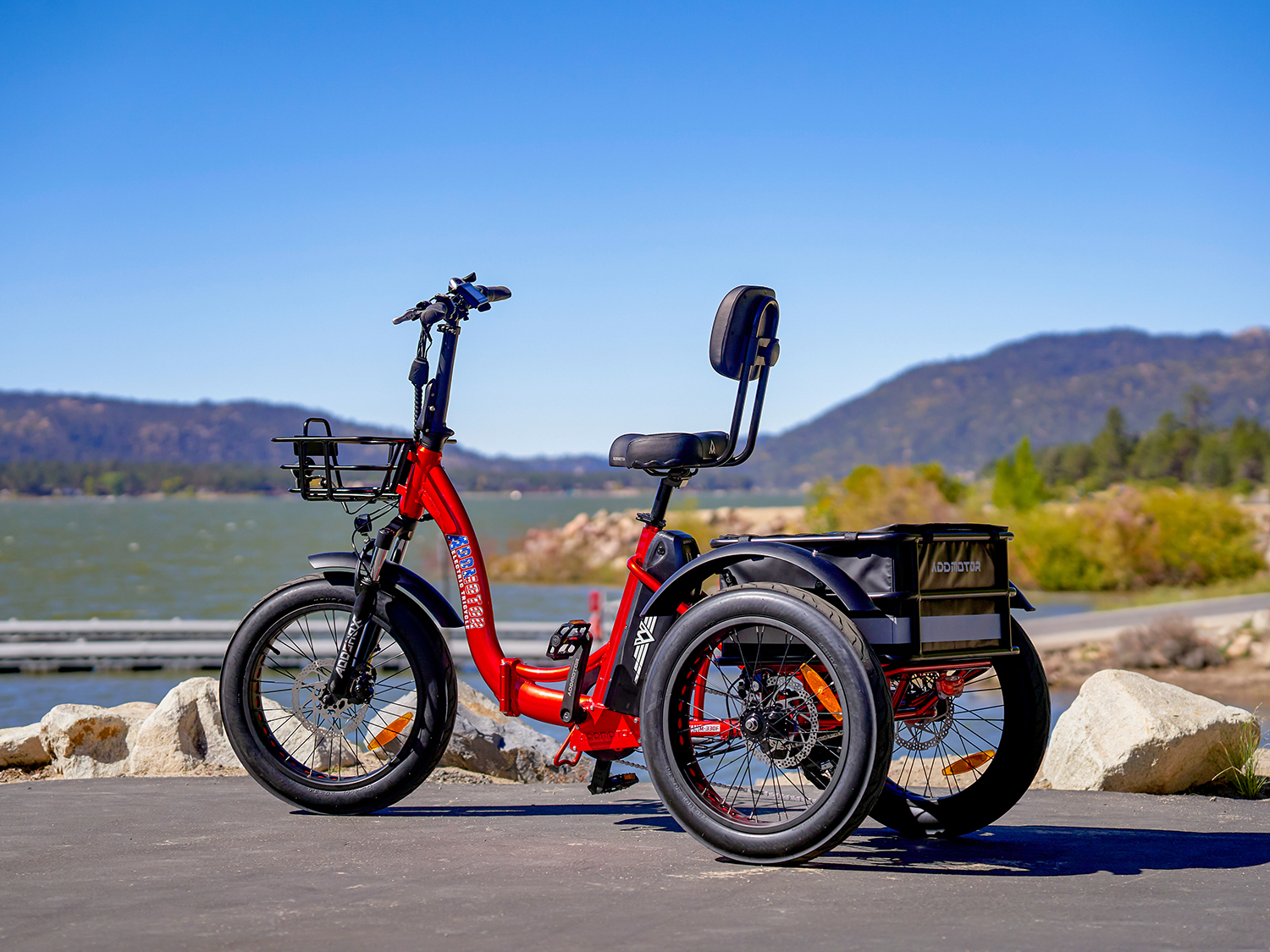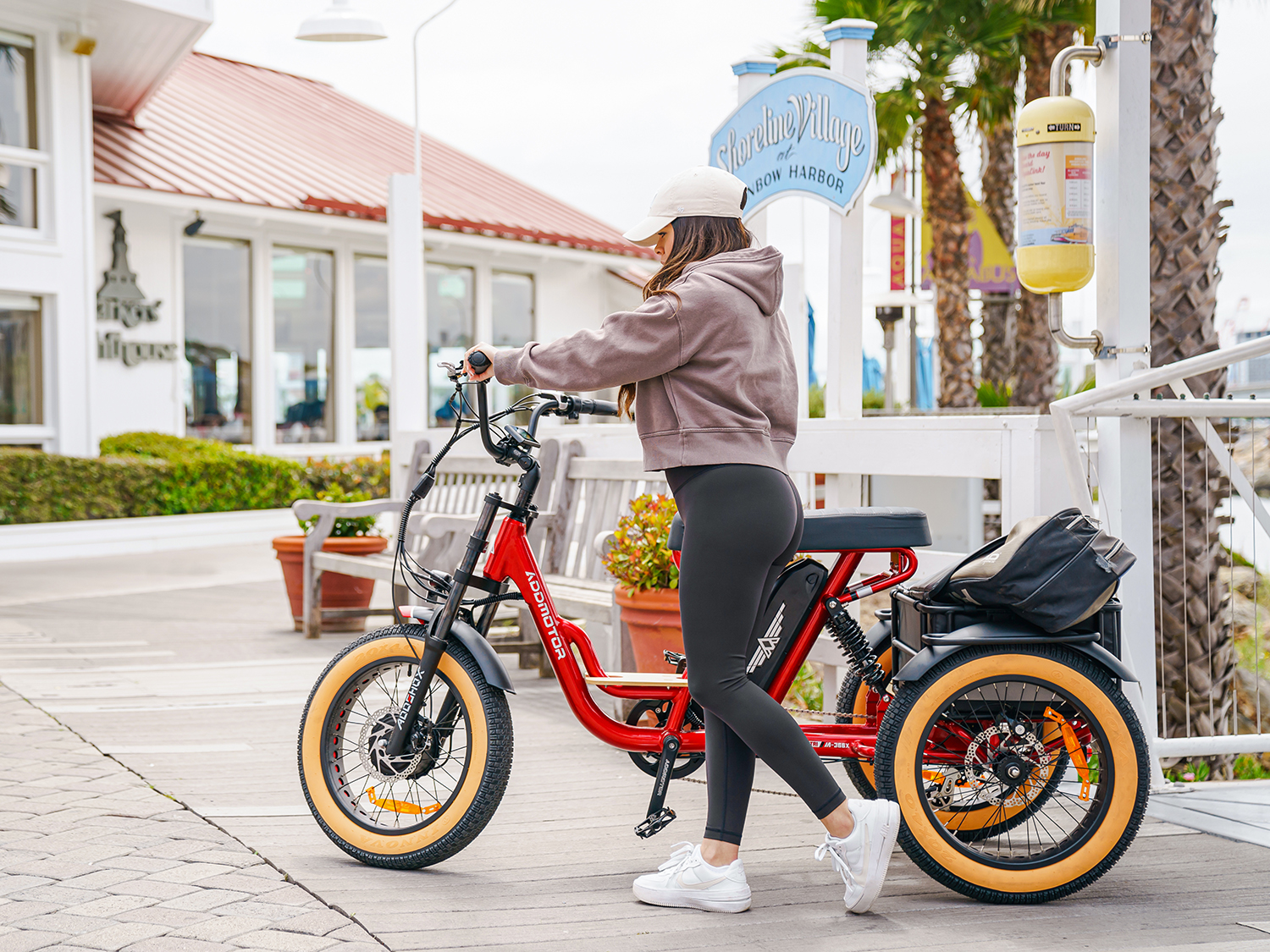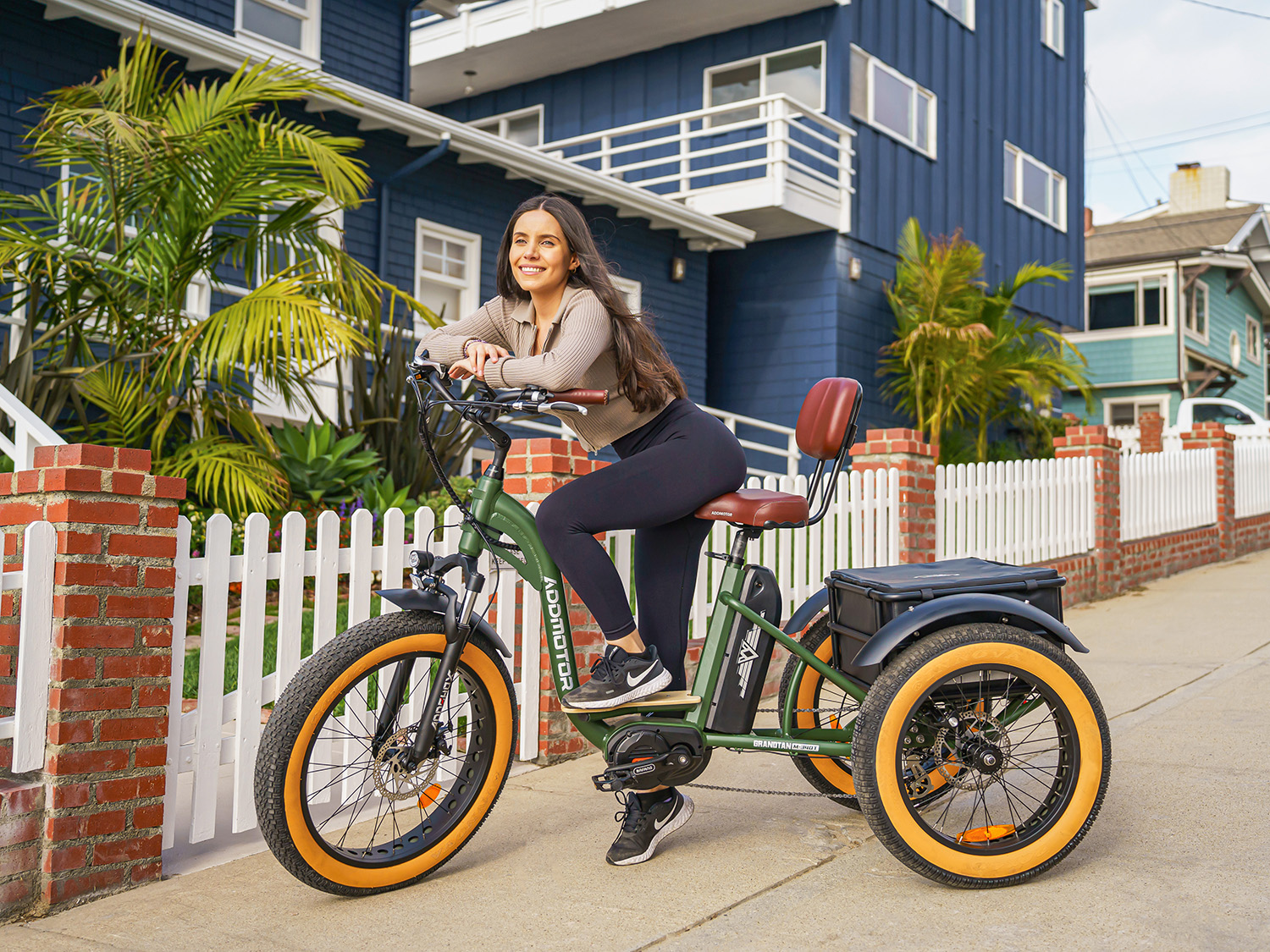Unveiling the Powerhouse: Exploring Electric Motors for Etrikes
By Addmotor | 13 November 2023 | 0 Comments
With the surge in popularity of these versatile three-wheelers in urban and rural landscapes alike, understanding the core component that powers them, the electric motor, becomes vital when it comes to choosing one.
This article is your comprehensive guide to understanding the right electric motor for your etrike, ensuring both performance and efficiency. We'll delve into the specifics of rear-mounted, mid-drive, and front-mounted motors, exploring their wattage range from 500W, 750W, and 1000W.
Whether you're a seasoned etrike commuter, an ebike enthusiast, or a curious traveler, this guide will illuminate the path to your perfect adult electric trike experience.
When it comes to making an etrike function, two primary types of motors are commonly used:
This type of motor can be mounted either at the rear or front wheel of the etrike, and each motor positioning has its situational advantages and disadvantages. Now, let's delve into the details of each:
The Rear-Mounted Motor
It is the most common type of hub motor, suitable for riders who frequently travel off-road on steep/slippery terrain.
Rear-mounted motors, like those in the Addmotor ARISETAN II M-360 and Triketan M-330F adult electric trike, sit snugly at the back of your trike. This positioning is great for enhancing traction and power. A rear-mounted motor can also handle higher speeds and heavier loads, making it suitable for off-road riding, cargo hauling, and hill climbing.

Advantages:
Disadvantages
The Front-Mounted Motor
Installed on the front wheel of the trike, this type of e-bike is tailored for everyday riders who navigate city streets and want a comfortable, safe, and reliable riding experience. These motors are versatile and can be seamlessly integrated with a diverse range of bikes featuring different drivetrains.
Front-mounted motors, like the one in the Addmotor Soletri M-366X adult electric trike, come with a 750W front Brushless Hub Motor. Positioned at the front, it offers an improved balance and handling of the etrike and allows the use of a standard rear axle and drivetrain.

Advantages
Challenges
Mid-drive motors, as seen in the Addmotor Grandtan Turbo, contribute to a stable and balanced riding experience. This motor excels in efficiency, responsiveness, balance, efficiency in power use, and translating to a smoother riding experience. Leveraging the trike's gears to maximize power and speed, it intelligently syncs with the rider's pedaling effort, aligning the motor power accordingly.

Pros
Cons
Here is a table that summarizes the key features of each type of electric trike motor:
Electric trike motors come in various wattages like 500, 750, and 1000 Watts, each suited to different riding styles and needs. The wattage of a motor plays a pivotal role in determining its power and, consequently, the etrike's performance.
Higher wattage generally means more power, but it's not just about speed. It's about finding the right balance for your riding needs, whether it's a leisurely ride or a robust commute.
For example, a motor with a 500W rating offers a gentle, energy-efficient ride, perfect for casual trips or flat terrains. Stepping up to 750W or 1000W, the power noticeably increases, offering more speed and the ability to tackle hills and carry heavier loads with ease.
However, higher wattage also means a greater draw on your battery, so consider your usual routes and riding style when choosing one.
Remember, the right motor not only enhances performance but also ensures a more enjoyable and sustainable ride.
This article is your comprehensive guide to understanding the right electric motor for your etrike, ensuring both performance and efficiency. We'll delve into the specifics of rear-mounted, mid-drive, and front-mounted motors, exploring their wattage range from 500W, 750W, and 1000W.
Whether you're a seasoned etrike commuter, an ebike enthusiast, or a curious traveler, this guide will illuminate the path to your perfect adult electric trike experience.
Types of Electric Motors for Etrikes
Fundamentally speaking, electric motors are the driving force behind the best electric trikes. They convert electrical energy into mechanical energy that ultimately helps to propel you forward.When it comes to making an etrike function, two primary types of motors are commonly used:
1. Hub motors and
2. Mid-drive motors
Hub Motors
Hub motors are integrated into the wheel hubs and these motors offer a straightforward design, making them popular among electric trike manufacturers. These motors are versatile and can be seamlessly integrated with a diverse range of bikes featuring different drivetrains.This type of motor can be mounted either at the rear or front wheel of the etrike, and each motor positioning has its situational advantages and disadvantages. Now, let's delve into the details of each:
The Rear-Mounted Motor
It is the most common type of hub motor, suitable for riders who frequently travel off-road on steep/slippery terrain.
Rear-mounted motors, like those in the Addmotor ARISETAN II M-360 and Triketan M-330F adult electric trike, sit snugly at the back of your trike. This positioning is great for enhancing traction and power. A rear-mounted motor can also handle higher speeds and heavier loads, making it suitable for off-road riding, cargo hauling, and hill climbing.

Advantages:
♦ With the weight of the motor at the rear, these best electric trikes offer superior traction and stability.
♦ The rear-mounted design offers better grip, especially on uphill climbs.
♦ It offers more power than a front-mounted motor.
Disadvantages
♦ It adds more weight and complexity to the rear axle.
♦ It can slightly impact the handling and maneuverability, especially during sharp turns, due to the weight distribution.
♦ A rear-mounted motor may increase the wear and tear of the rear tire and brake.
The Front-Mounted Motor
Installed on the front wheel of the trike, this type of e-bike is tailored for everyday riders who navigate city streets and want a comfortable, safe, and reliable riding experience. These motors are versatile and can be seamlessly integrated with a diverse range of bikes featuring different drivetrains.
Front-mounted motors, like the one in the Addmotor Soletri M-366X adult electric trike, come with a 750W front Brushless Hub Motor. Positioned at the front, it offers an improved balance and handling of the etrike and allows the use of a standard rear axle and drivetrain.

Advantages
♦ Helps you to ride on any terrain with ease.
♦ The front-mounted motor is easier and cheaper to install and maintain.
♦ It enhances the electric trike’s weight distribution.
Challenges
♦ It might offer less traction compared to its rear-mounted counterpart, especially on slippery or uneven surfaces.
♦ This could lead to steering issues at higher speeds.
♦ It causes the front wheel to spin or skid when accelerating or braking and interfering with the steering and suspension of the trike.
The Mid-Drive Motor
A mid-drive motor is a motor that is mounted in the middle of the trike, fixed at the crankset between the two pedals. It works by powering the chain or the belt that drives the rear wheel, affecting the pedaling and the gears.Mid-drive motors, as seen in the Addmotor Grandtan Turbo, contribute to a stable and balanced riding experience. This motor excels in efficiency, responsiveness, balance, efficiency in power use, and translating to a smoother riding experience. Leveraging the trike's gears to maximize power and speed, it intelligently syncs with the rider's pedaling effort, aligning the motor power accordingly.

Pros
♦ Mid-drive motors excel in distributing weight evenly across the bike, leading to a more balanced ride.
♦ Offer more power for cyclists.
♦ Help the best electric trikes climb steep hills more effectively.
Cons
♦ Add more stress and wear to the chain and the gears, making the trike harder to pedal without electric assistance.
♦ Can be complex in terms of maintenance and might be on the higher end of the price spectrum.
Here is a table that summarizes the key features of each type of electric trike motor:
| Characteristic / Types | Rear-mounted hub motor | Front-mounted hub motor | Mid-drive motor |
| Power | Offers high power | Delivers medium power | Boasts high power |
| Speed | High-speed capabilities for swift rides | Maintains a moderate speed | High-speed potential for exhilarating rides. |
| Efficiency | Exhibits moderate efficiency | Lower efficiency | Demonstrates high-efficiency |
| Responsiveness | Lower responsiveness, impacting quick acceleration. | Shows moderate responsiveness for a balanced ride. | Highly responsive, ensuring quick and precise control. |
| Traction | Provides high traction, enhancing grip on various surfaces. | Shows lower traction, potentially affecting stability. | Offers medium traction, balancing grip, and maneuverability. |
| Stability | Ensures high stability, providing a secure riding experience. | May compromise stability due to front-wheel drive. | Maintains medium stability, balancing performance and control. |
| Maneuverability | Exhibits lower maneuverability, impacting agility in tight spaces. | Offers higher maneuverability | Provides medium maneuverability, balancing agility, and control. |
| Installation | Requires medium-level installation effort and expertise. | Involves low installation complexity for user convenience. | Demands high-level installation effort and expertise. |
| Maintenance | Involves lower maintenance | Requires low maintenance | Necessitates high maintenance for optimal performance. |
Which E-trike Motor is Good for You 500W, 750W, or 1000W?
Electric trike motors come in various wattages like 500, 750, and 1000 Watts, each suited to different riding styles and needs. The wattage of a motor plays a pivotal role in determining its power and, consequently, the etrike's performance. Higher wattage generally means more power, but it's not just about speed. It's about finding the right balance for your riding needs, whether it's a leisurely ride or a robust commute.
For example, a motor with a 500W rating offers a gentle, energy-efficient ride, perfect for casual trips or flat terrains. Stepping up to 750W or 1000W, the power noticeably increases, offering more speed and the ability to tackle hills and carry heavier loads with ease.
However, higher wattage also means a greater draw on your battery, so consider your usual routes and riding style when choosing one.
Conclusion
Choosing the right motor for your e-trike can dramatically enhance your riding experience. Consider your personal needs; are you seeking stability, balance, or simplicity? Your answer will guide you to the perfect motor choice.Remember, the right motor not only enhances performance but also ensures a more enjoyable and sustainable ride.
Leave a Reply
Your email address will not be published.Required fields are marked. *
Latest Stories

_1744164598.webp)

_1743148189.webp)
_1743148249.webp)